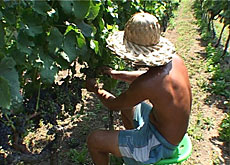Bon viveurs wine and dine in Ticino hideaway

A small restaurant tucked away in a vineyard in Ticino has become a top destination among lovers of mouth-watering local cuisine and fine Swiss wines.
The Fattoria L’Amorosa – owned by one of the region’s biggest winemakers – also offers exquisite accommodation for those in search of natural beauty and rustic charm.
Owner Angelo Delea says the idea of setting up his farmhouse-style retreat came about when he decided to expand his wine emporium in 1998.
“I bought up this site of five hectares to be able to grow more grapes and olive trees, but it was so beautiful here that I decided to build somewhere where my customers could stay to soak up the atmosphere,” Delea tells me.
Creature comforts
Five years on, the Fattoria attracts holidaymakers looking for an alternative to hotels, but who still hanker for their creature comforts.
“Agritourism is a relatively new trend and it’s starting to take off in Ticino, but a lot of the farmhouse-style accommodation on offer here isn’t as sophisticated as the Fattoria,” says Michaela Frascalini of Ticino Tourism.
Delea, a former restaurateur, says he was inspired by the wealth and range of farmhouse accommodation in Tuscany.
“I wanted to raise the standard of Ticino’s agritourism, which is still quite low,” Delea explains. “And I think we’ve struck a balance between something sophisticated and rustic.”
But he says he had to overcome many bureaucratic hurdles before being able to get the project underway.
“It’s very difficult [in Ticino] to attract the investment needed [to create something more upmarket] because the legislation is very restrictive. It’s a shame because there are lots of tourists who are keen to spend their holidays in this way.”
Home-grown produce
All seven rooms are lovingly decorated with antiques from old country houses, and there is a lounge where guests can relax with a glass of one of Delea’s 20 or so wines, 60 per cent of which are made using Ticino’s main grape variety, Merlot.
On sunny days, breakfasts and meals are served on the terrace, which overlooks endless rows of vines, tightly packed on the steep hillside. There are also olive groves and herb and vegetable gardens.
“About two-thirds of the food we use in the restaurant comes from the grounds, the rest comes from specialised local suppliers,” restaurant chef Alberto Giacone explains.
Giacone, who prepares food in an open area of the restaurant, says he gets a lot more satisfaction from working at the Fattoria than he would in a hotel restaurant.
“I feel like I can promote agritourism just by cooking great food,” he smiles.
Fine vines
Despite the success of the Fattoria, winemaking is Delea’s main business, and he now has 20,000 hectares of vines and a ten per cent share of Ticino’s wine market.
“We cultivate mostly Merlot, and some Cabernet Franc, Cabernet Sauvignon and Petit Verdau grapes,” he says. “We’re always experimenting with the way we grow the vines by adopting methods of other cantons.”
He points out an area where the vines are planted along a terrace, spaced further apart than on the steeper inclines around the Fattoria. “That’s the way they plant the vines around the Valais and it’s working well here too.”
“And with the hot, dry summer we’ve had, it should be the winemaking year of the century.”
swissinfo, Vanessa Mock in Ticino
The Fattoria L’Amorosa is located on a wide terrace of 15,000 hectares between Gudo and Semantina, west of Bellinzona, canton Ticino.
Bed and breakfast prices start at SFr120 per night per person.
Angelo Delea founded his wine company in 1983, inspired by the Bordeaux type of winemaking, where the wine is aged in precious oak barrels.
The Fattoria is included in Switzerland Tourism’s new wine and gastronomy tour.
Merlot is the most commonly used grape in Ticino, accounting for around 70 per cent of total production.
Other grape varieties include Chardonnay, Pinot Noir, Semillon and Cabernet Sauvignon.
Ticino is Switzerland’s fourth-largest wine growing region after canton Valais, Vaud and Geneva.

In compliance with the JTI standards
More: SWI swissinfo.ch certified by the Journalism Trust Initiative










You can find an overview of ongoing debates with our journalists here . Please join us!
If you want to start a conversation about a topic raised in this article or want to report factual errors, email us at english@swissinfo.ch.